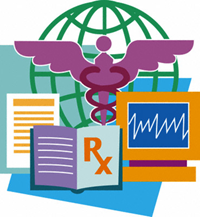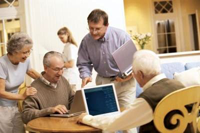
Nurses and E-health
Overview
 "The Internet allows us to stop being gatekeepers and start sharing information,” says Judy Norris, the Toronto nursing systems expert who set up Nurse Net just eighteen months ago. “We will be part of a global network of people - researchers, families, nurses, people with diseases - all sharing health information. Nurses will be the brokers of this knowledge; helping consumers access the information they need and deciding how to use it.”
(B. Sibbald, 1995, p. 33).
 A critically important wave of network evolution is the public use of the Internet for networking with health care providers and other members of the public, now called E-health. Essentially, E-health is a client-centered World Wide Web-based network where clients and health care providers collaborate through ICT mediums to research, seek, manage, deliver, refer, arrange, and consult with others about health related information and concerns (Moody, 2005; Conte, 1999). “The spread of powerful computers among a large and rapidly increasing segment of the population, and their interconnection through the Internet and millions of powerful servers, has brought an entirely new and largely unexpected quality to health and health informatics, and is effecting changes that we are only beginning to fathom. Essentially, it provided a vehicle to tie the general population in a new way into the system of health provision, health maintenance and health care. According to many assessments, health care is among the foremost reasons for resorting to the Internet” (Moehr & Grant, 2000, p. 278). A critically important wave of network evolution is the public use of the Internet for networking with health care providers and other members of the public, now called E-health. Essentially, E-health is a client-centered World Wide Web-based network where clients and health care providers collaborate through ICT mediums to research, seek, manage, deliver, refer, arrange, and consult with others about health related information and concerns (Moody, 2005; Conte, 1999). “The spread of powerful computers among a large and rapidly increasing segment of the population, and their interconnection through the Internet and millions of powerful servers, has brought an entirely new and largely unexpected quality to health and health informatics, and is effecting changes that we are only beginning to fathom. Essentially, it provided a vehicle to tie the general population in a new way into the system of health provision, health maintenance and health care. According to many assessments, health care is among the foremost reasons for resorting to the Internet” (Moehr & Grant, 2000, p. 278).
Although E-health developed from the telehealth network movement, it is a unique phenomena in two ways: networks and resources devoted to E-health have developed on the Internet at an amazing rate over the past decade or so, and the emphasis is genuinely client focused. “It differs from telehealth or telemedicine in that e-health is Internet-based and includes a range of services, nursing or healthcare, health education, and medication prescription or refills via e-prescribing. In conjunction, telemonitoring devices may be used, via a Universal Serial Bus (USB) port on the patient's computer, to collect additional physiologic data (e.g blood pressure, pulse, temperature, weight, spirometry, blood glucose, and oxygen saturation levels)” (Moody, 2005, p. 157).
 The phenomenal growth of E-health can not generally be credited to the health care system or its employed social actors. Rather, clients driven by the need and urge to become informed health consumers and participants have catalyzed this new style of networking, clients who have learned to utilize ICTs in the form of the Internet to meet their health concern needs. Although statistics show that women are underrepresented in Internet usage, women tend to access the Internet more than men to seek health related information and networking (Henwood, Wyatt, Hart & Smith, 2003). “The notion of informed choice is inductive of the greater agency and sense of empowerment said to be experienced by such patients. The dominant discourse here is said to be one of rights, where patients have the right to information and are treated as individuals, not treatment opportunities” (p. 591). The phenomenal growth of E-health can not generally be credited to the health care system or its employed social actors. Rather, clients driven by the need and urge to become informed health consumers and participants have catalyzed this new style of networking, clients who have learned to utilize ICTs in the form of the Internet to meet their health concern needs. Although statistics show that women are underrepresented in Internet usage, women tend to access the Internet more than men to seek health related information and networking (Henwood, Wyatt, Hart & Smith, 2003). “The notion of informed choice is inductive of the greater agency and sense of empowerment said to be experienced by such patients. The dominant discourse here is said to be one of rights, where patients have the right to information and are treated as individuals, not treatment opportunities” (p. 591).
 Informed, reflective clients in the health care system have encountered some degree of alarm and reluctance from members of the health team, since the notion requires a change in the dynamics of provider-patient or provider-client interactions. “It is clear that the informed patient will not emerge naturally or easily within existing structures and relationships. Constraints exist within both practitioner and patient communities and within the space occupied by both in the medical encounter” (Henwood et al, 2003, p. 605). E-health networks that support interactions between knowledgeable clients who have assumed a position of control and choice in their own health care and reciprocal health professionals depend upon a shift in perspective on the part of health care providers, especially in medicine and nursing. A health care landscape that is conducive to a partnership level of interaction is critical, while the onus of control rests with the client (Moehr & Grant, 2000). “These trends are also leading informatics, as an information-intensive industry, to become a major pillar of health care. Because the person is the only element in common across institutional, organizational, and national boundaries, we come full circle, to the need to re-design systems around the person, that is, to patient centered informatics. IT facilitates the transmission of health care information without regard to location; it contributes to the trend toward boundary-less delivery of both health information and health care” (Kaplan, Flatley-Brennan, Dowling, Friedman & Peel, 2001, p. 240). Informed, reflective clients in the health care system have encountered some degree of alarm and reluctance from members of the health team, since the notion requires a change in the dynamics of provider-patient or provider-client interactions. “It is clear that the informed patient will not emerge naturally or easily within existing structures and relationships. Constraints exist within both practitioner and patient communities and within the space occupied by both in the medical encounter” (Henwood et al, 2003, p. 605). E-health networks that support interactions between knowledgeable clients who have assumed a position of control and choice in their own health care and reciprocal health professionals depend upon a shift in perspective on the part of health care providers, especially in medicine and nursing. A health care landscape that is conducive to a partnership level of interaction is critical, while the onus of control rests with the client (Moehr & Grant, 2000). “These trends are also leading informatics, as an information-intensive industry, to become a major pillar of health care. Because the person is the only element in common across institutional, organizational, and national boundaries, we come full circle, to the need to re-design systems around the person, that is, to patient centered informatics. IT facilitates the transmission of health care information without regard to location; it contributes to the trend toward boundary-less delivery of both health information and health care” (Kaplan, Flatley-Brennan, Dowling, Friedman & Peel, 2001, p. 240).
 Nurses can be primary actors in the virtual arena of E-health, serving as health advisors, Internet guides to help clients select reliable information resources, support group liaisons, web information providers, and so on. Nurses need to be involved in the design and implementation of E-health portals and programs that provide the best possible E-health experience for health care clients. Designers of such programs should be directed to “...build tools to enable individuals to become involved in their cure no matter where they are. Such tools may include programs for monitoring one's own health and health behaviours, tools for accessing quality information, and tools for communicating with others in like circumstances or with health professionals” (Kaplan et al, 2001, p. 239). Nurses can be primary actors in the virtual arena of E-health, serving as health advisors, Internet guides to help clients select reliable information resources, support group liaisons, web information providers, and so on. Nurses need to be involved in the design and implementation of E-health portals and programs that provide the best possible E-health experience for health care clients. Designers of such programs should be directed to “...build tools to enable individuals to become involved in their cure no matter where they are. Such tools may include programs for monitoring one's own health and health behaviours, tools for accessing quality information, and tools for communicating with others in like circumstances or with health professionals” (Kaplan et al, 2001, p. 239).
It is becoming obvious, that many clients want health care that is “highly personalized, customized, targeted, with tailored information and ultimately care delivery and case management” (Kaplan & Flatley Brennan, 2001, p. 311). This has led to the evolution of many client managed E-health initiatives that serve as self-help or support group networks. Initiators of these networks embrace the role of significant provider as well as user of health information, providing advice and a virtual environment that invites interaction with others who are focused on the same health issues and questions (Henwood et al, 2003). The levels of affiliation and interaction that develops within some of these networks are truly inspirational to health care providers who wish to engage in E-health networks with clients. Nurses can become visible social agents within these networks, interacting with informed, reflective public agents who have the desire and capabilities to make the health care choices that suit their own life world and personal values.
Ends in View
This learning activity is intended to give the learner the opportunity to:
1. Explore the potential venues for collaboration with peers, interdisciplinary team members, clients, and client groups in developing meaningful and useful E-health initiatives.
2. Understand the current computer applications available to facilitate online collaboration for both clients and nurses.
3. Design and plan an E-health initiative within a selected area of practice and/or for a specific client group.
In Preparation
1. READ: Benton Foundation. (1999). Networking for Better Care: Health Care in the Information Age. Washington, DC: Benton Foundation and Robert Wood Foundation.
2. READ: Bandura, A. (2002). Growing primacy of human agency in adaptation and change in the electronic era. European Psychologist, 7(1), 2-16.
3. READ: Moody, L. (2005). E-health web portals: Delivering holistic healthcare and making home the point of care. Holistic Nursing Practice, 19(4), 156-160.
4. READ: Kaplan, B. & Flatley Brennan, P. (2001). Consumer informatics supporting patients as co-producers of quality. Journal of the American Medical Informatics Association, 8(4), 309-316.
5. READ: Henwood, F., Wyatt, S., Hart, A. & Smith, J. (2003). 'Ignorance is bliss sometimes': Constraints on the emergence of the 'informed patient' in the changing landscape of health information. Sociology of Health and Illness, 25(6), 589-607.
In Practice
1. CONSIDER: the points made about eHealth, client rights and needs, and consumer informatics in the readings as you begin to plan an eHealth initiative that could serve a selected area of practice, individual client or client group. Also consider the principles of confidentiality, security and privacy addressed in the learning activity for Nursing 2241.
2. DOWNLOAD: The eHealth Initiative Planning Worksheet and complete. As you do so, imagine that you have unlimited resources at your command, including technological support, funding, time, and an eager client recipient group.
In Reflection
1. How can nurses improve the collegial climate of the health care system to help interdisciplinary acceptance of informed client groups who demand reliable and meaningful E-health services?
2. What skills and knowledge would you need to develop to participate actively as a health professional within the E-health milieu?
3. What future trends in E-health do you predict in Canada?
References
Henwood, F., Wyatt, S., Hart, A. & Smith, J. (2003). 'Ignorance is bliss sometimes': Constraints on the emergence of the 'informed patient' in the changing landscape of health information. Sociology of Health and Illness, 25(6), 589-607.
Kaplan, B. & Flatley Brennan, P. (2001). Consumer informatics supporting patients as co-producers of quality. Journal of the American Medical Informatics Association, 8(4), 309-316.
Kaplan, B., Flatley Brennan, P., Dowling, A., Friedman, C. & Peel, V. (2001). Towards an informatics research agenda: Key people and organizational issues. Journal of the American Medical Informatics Association, 8(3), 235-241.
Moehr, J. & Grant, A. (2000). Medical informatics and medical education in Canada in the 21st century. Clinical Investigative Medicine, 23(4), 275-280.
Moody, L. (2005). E-health web portals: Delivering holistic healthcare and making home the point of care. Holistic Nursing Practice, 19(4), 156-160.
Sibbald, B. (1995). 2020 - Vision of the Future. The Canadian Nurse, March, p. 33-36.
NEXT: Nursing Decision Support and Expert Systems
& Artificial Intelligence .... . .
|